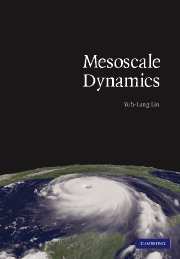Book contents
- Frontmatter
- Contents
- Preface
- 1 Overview
- 2 Governing equations for mesoscale motions
- 3 Basic wave dynamics
- 4 Mesoscale wave generation and maintenance
- 5 Orographically forced flows
- 6 Thermally forced flows
- 7 Mesoscale instabilities
- 8 Isolated convective storms
- 9 Mesoscale convective systems
- 10 Dynamics of fronts and jet streaks
- 11 Dynamics of orographic precipitation
- 12 Basic numerical methods
- 13 Numerical modeling of geophysical fluid systems
- 14 Parameterizations of physical processes
- Appendices
- Index
- References
3 - Basic wave dynamics
Published online by Cambridge University Press: 15 December 2009
- Frontmatter
- Contents
- Preface
- 1 Overview
- 2 Governing equations for mesoscale motions
- 3 Basic wave dynamics
- 4 Mesoscale wave generation and maintenance
- 5 Orographically forced flows
- 6 Thermally forced flows
- 7 Mesoscale instabilities
- 8 Isolated convective storms
- 9 Mesoscale convective systems
- 10 Dynamics of fronts and jet streaks
- 11 Dynamics of orographic precipitation
- 12 Basic numerical methods
- 13 Numerical modeling of geophysical fluid systems
- 14 Parameterizations of physical processes
- Appendices
- Index
- References
Summary
Introduction
When an air parcel is displaced from its initial position, a restoring force may cause it to return to its initial position. In doing so, inertia will cause the air parcel to overshoot and pass its initial equilibrium position moving in the opposite direction from that in which it is initially displaced, thereby creating an oscillation around the equilibrium position. Concurrently, a wave is produced that propagates from this source region to another part of the fluid system, which is the physical medium of wave propagation. A physical restoring force and a medium for propagation are the two fundamental elements of all wave motion in solids, liquids, and gases, including atmospheric waves, oceanic waves, sound (acoustic) waves, wind induced waves, seismic waves, or even traffic density waves. The ultimate behavior of the wave is dictated by the individual properties of the restoring force responsible for wave generation and the medium through and by which the wave propagates energy and momentum.
From scaling arguments of the so-called primitive equations based on horizontal scales of fluid motion, some of the more important categories of waves observed in the atmosphere may be classified as follows (Table 3.1): (a) sound (acoustic) waves, (b) mesoscale waves, and (c) planetary (Rossby) waves. In this chapter, mesoscale waves are defined in a more general manner, referring to waves that exist and propagate in the atmosphere with a mesoscale wavelength.
- Type
- Chapter
- Information
- Mesoscale Dynamics , pp. 22 - 63Publisher: Cambridge University PressPrint publication year: 2007



